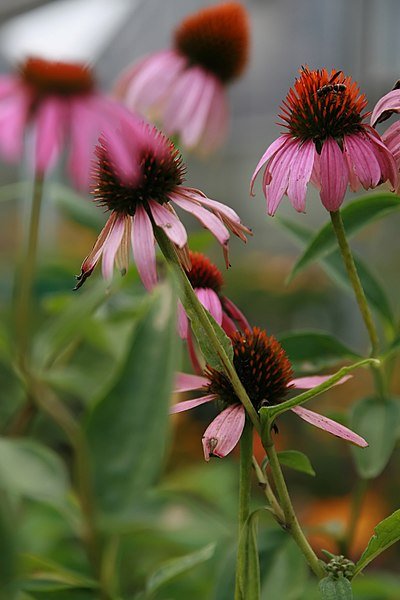Echinacea angustifolia
main article: https://treeleavesoracle.com/lore/?p=120
purchase from https://technotink.net/treasure/product/echinacea-angustifolia/
also known as Black Sampson, purple coneflower, coneflower, Rudbeckia
Medicinally: Echinacea Angustifolia is used to boost the immune system, and folklore suggests it wards off colds and flu. If taken in high doses, its effectiveness decreases. It is said to have anti-inflammatory properties. It was used by Native Americans to treat snakebites, burns, toothaches, colds, flu, sore throats, headaches, gonorrhea, mumps, tonsilitis, and smallpox. The juice from the plant is said to prevent burns. The roots were believed a blood purifier to cure a wide variety of ailments such as rheumatism, streptococcus infections, bee stings, poisonous snakebites, dyspepsia, tumors, syphilis, gangrene, eczema, hemorrhoids, and pains/wounds. It is considered an effective antibiotic. Chewing the root or using it as a tea is used for snake bites, spider bites, cancers, toothaches, burns, hard-to-heal sores, wounds, flu, and colds. Decoctions of the roots for snakebites and hydrophobic and the macerated root used as an anesthetic or cold medicine. Chewing root and letting the juice coat the throat is good for colds and sore throats. It has been said to have the ability to lower blood sugar levels, anti-proliferation effects especially in pancreatic cancer cells. There has been some scientific research to support folklore. In the 1920’s it was considered a cure-all and one of the most popular plant drugs in the United States.
Magically: Its power is to strengthen spells and was used by Native American Indians as an offering to spirits to ensure and strengthen spells or prayers. The juice from the plant was added to water sprinkled on coals during traditional sweat lodge ceremonies and/or taken for purification purposes. According to Gaea and Shandor Weiss’ book “Growing and Using the Healing Herbs,” some Native Americans used the juice to make their hands, feet, and mouths insensitive to heat to hold, walk on, or swallow hot coals and fire during ceremonies.
The plant: A perennial flower that grows approximately 18-24 inches tall, rarely branched, with oblong leaves covered with stiff hairs, producing pinkish-lavender ray petals borne singly atop the stems from a flower head that is dark, spiny, cone-shaped. It blooms in May, June, and July usually and can be found in woodland edges or openings, prairies, plains, meadows, pastures, and savannahs in North America. It has spindle-shaped taproots that are branched. It belongs to the sunflower family. Angustifolia has more alkylamines than its subspecies purpurea which support the suppression and the activation of the immune system.
Other Uses: ornamental garden plant.
keywords: Echinacea angustifolia, black sampson, purple coneflower, coneflower, rudbeckia, immune system, colds, flu, anti-inflammatory, snakebites, burns, toothaches, sore throats, headaches, gonorrhea, mumps, tonsilitis, smallpox, burns, blood purifier, rhuematism, streptococcus, bee stings, dyspepsia, tumors, syphilis, gangrene, eczema, hemorrhoids, wounds, antibiotic, hydrophobic, anesthetic, lower blood sugar, pancreatic cancer, offerings, strengthen spells, purification, fire, ornamental
References:
- Cunningham, Scott 1992 “Cunningham’s Encyclopedia of Magical Herbs”. Llwellyn: St. Paul, Minnesota.
- Kowalchik, Claire; Hylton, William 1987 “Rodale’s Illustrated Encyclopedia of Herbs”. Rodale Press: Emmaus, Pennsylvania.
- Prarie Moon Nursery n.d. “Narrow-Leaved Coneflower” website referenced 6/23/21 at https://www.prairiemoon.com/echinacea-angustifolia-narrow-leaved-coneflower-prairie-moon-nursery.html
- Wikipedia n.d. “Echinacea angustifolia” website referenced 6/23/21 at https://en.wikipedia.org/wiki/Echinacea_angustifolia
- wildflower.org n.d. “Echinacea angustifolia” Plant Database, University of Texas. Website referenced 6/23/21 at https://www.wildflower.org/plants/result.php?id_plant=ecan2
Photos from Wikipedia Creative Commons, public domain:




1 thought on “Echinacea angustifolia: Purple Coneflower”
Comments are closed.